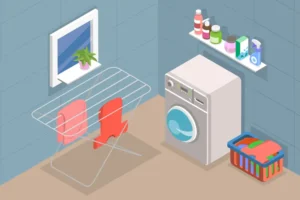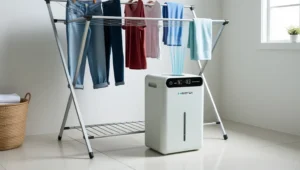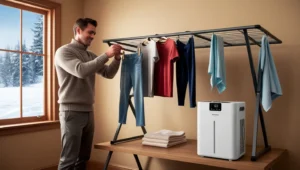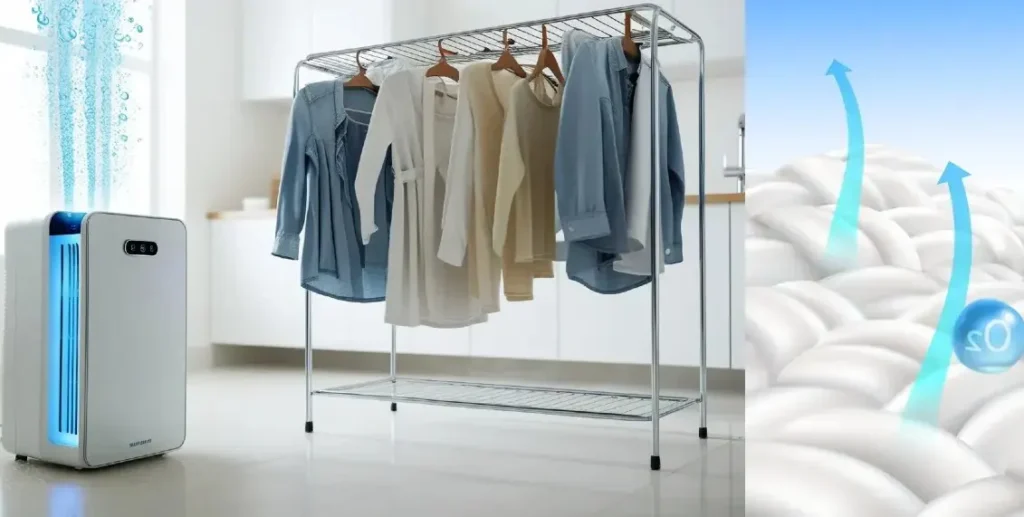Can dehumidifier dry cloth?
Yes, dehumidifiers can dry cloth. It’s built to absorb moisture/water from the air. Because of its nature, it can play a significant role in drying your clothes at home or in the dryer room. You can save a lot of time by using a dehumidifier. Normally it takes 7-8 hours to dry cloth. The thing is, if you already have a dehumidifier at home and want to use it for drying cloth. then it will be a choice. but if you are planning to buy a dehumidifier for drying cloth in your home & laundry area, then hold on, there are much better options for you, which consume similar electricity as dehumidifiers do. And it can dry your clothes in 90 minutes. If you don’t have issues with time for drying clothes at home, then choose a dehumidifier. it will be a good choice for you, because of its dual purpose work. You can easily move it between different rooms to control the humidity. And if you want a quick result then go for a heat pump dryer. In this blog, we will discuss the right way to dry clothes with a dehumidifier, dry for winter sessions, when you should go for a heat pump dryer and many more things.

To make the process faster & efficient, reduce the water from the cloth as much as possible by making some extra spin in the washing machine or twisting it by hand. This way you already remove some water before your dehumidifier does, by doing this you are putting much lower pressure on the dehumidifier. Because of this the drying process will be faster and also the dehumidifier will consume less electricity.

The hanging of the cloth needs to be very precise so that the air can flow properly between every cloth. Otherwise, you will not get a good result. So make sure you don’t overcrowd your clothes. There are useful tools you can use to hang your clothes. It’s called a cloth drying rack, you can use it for better results.

Take your dehumidifier in the cloth drying rack or near it. Set it on dryer mode. Before placing the dehumidifier, make sure there is a 30 cm gap between the wall and the dehumidifier. Otherwise, air circulation issues will happen. Also after the air gets pushed by the wall, it will try to return to the dehumidifier. This can be a cause of overheating and because of that your compressor will get damaged. After a few hours, I rotated the cloth drying rack, to get a better result. By using this way your cloth will dry 50% faster than the regular drying process.
If you buy a dehumidifier for drying cloth, then you can also use it to control your room’s humidity.

In winter, washing & drying is a painful thing. This particular time we hang a lot of clothes inside the house. The problem is when the heater is on inside the home, it takes days to dry the clothes. Especially towels, jeans pants, jackets, shoes, etc cloth takes much time to dry. But using a dehumidifier you can minimize the time. Just wash your clothes and hang them in a separate room. Set the dehumidifier and within the morning your clothes will be dry.

Another problem of winter is condensation at night time. Well you can use the dehumidifier to get a solution from it. Best thing is the flexibility of using a dehumidifier. You can place it in any room you want, just move it, connect it to the electricity then turn it on. Using a dehumidifier is very simple.
We have 5 members in our home and my little sister reads in 6th class. Because of that, a lot of clothes get dirty in a short time. It’s hard to hang all the clothes outside. Thankfully I have a dehumidifier at home. Whenever I use it, after 2 hours the humidity level starts to decrease. Nowadays every dehumidifier gets smarter. They come with a lot of different modes, which allow us to get more control. Some dehumidifiers have Bluetooth connectivity options. They have an app, where you can see all the details, such as how much electricity they consume, performance details, temperature and other details.
There is a negative side of it, that is the sound issue. Every dehumidifier has this sound issue, which is annoying at night. But as I said, I used a different room for dry clothes. For that reason it doesn’t disturb me. To be honest, dehumidifiers release very minimal noise, less than a fan does. If you buy the latest models, you will not suffer from dehumidifier noise issues.
Is a dehumidifier cheaper than tumble dryers to dry clothes?
If we use a dehumidifier to dry cloth, then we should know how much electricity it takes to do its job. In regular mode, it consumes 0.6 kWh of electricity and takes around 20 hour to dry cloth. If you try this, your result can be a little different because it depends on your humidity level.

In the laundry mode, the dehumidifier consumes very high electricity and takes 8 hours to dry the cloth. its not acceptable for me.
on the other hand, Heat pumps consume 0.8 KWH and take 1.5 Hours to dry cloth. This is crazy, that it consumes electricity almost similar to the dehumidifier and the result is 10 times faster. I am not saying that a dehumidifier is useless. It’s a good option for home and basic use. But if you are planning to get a dehumidifier for only drying cloth then hold on and go for heat pumps.
It would be interesting to see the dehumidifier results if you put the clothes in a small room or inside a homemade “tent”, trust me by doing this your dehumidifier will dry your clothes even faster. Try this by your self and if you see that it looks like 6 hours, then use the timer mode. by doing this the dehumidifier will automatically turn off after 6 hours and it will minimize the electricity consumption for your home. Nowadays there are some models that consume less energy in dryer mode and not everyone has a heat pump, also not everyone has a dryer. In this case, a dehumidifier is 100% the best next choice in my opinion.

